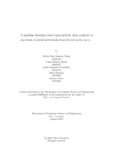| dc.contributor.advisor | Turzo, Esfar E Alam | |
| dc.contributor.author | Nahar, Fatiha Binte Kamrun | |
| dc.contributor.author | Afsana, Umme Halima | |
| dc.contributor.author | Chowdhury, Azizul Muktadir | |
| dc.contributor.author | Hasnaen, Maha | |
| dc.contributor.author | Jahan, Sumaya | |
| dc.date.accessioned | 2023-12-18T06:35:07Z | |
| dc.date.available | 2023-12-18T06:35:07Z | |
| dc.date.copyright | 2023 | |
| dc.date.issued | 2023-01 | |
| dc.identifier.other | ID: 19101500 | |
| dc.identifier.other | ID: 19101427 | |
| dc.identifier.other | ID: 22341040 | |
| dc.identifier.other | ID: 19141002 | |
| dc.identifier.other | ID: 22241182 | |
| dc.identifier.uri | http://hdl.handle.net/10361/22003 | |
| dc.description | This thesis is submitted in partial fulfillment of the requirements for the degree of Bachelor of Science in Computer Science, 2023. | en_US |
| dc.description | Cataloged from PDF version of thesis. | |
| dc.description | Includes bibliographical references (pages 39-40). | |
| dc.description.abstract | In this research, we propose a hybrid model for predicting suicide risk from text
data that incorporates BERT, VADER, and a Random Forest classifier for sentiment
analysis. This model aims to identify individuals who may be at risk of committing
suicide based on the tone of the text. The model is trained on a labelled dataset
of text data that is either classified as ”suicide” or ”not suicide,” which provides
the model with instances of text data that are linked with high or low suicide risk
respectively. In order to extract feature representations of the text data, the BERT
model is utilized, and the VADER model is utilized in order to extract sentiment
ratings for each individual text. These features are integrated into a single feature
vector for each text, and then the Random Forest classifier is trained using this
feature vector. A number of different metrics, including accuracy, precision, recall,
and F1-score, are utilized in order to assess the performance of the model. The
findings of this research indicate that the hybrid model that was suggested is capable
of accurately predicting the risk of suicide based on text data and that it is suitable
for use as a tool to help clinical decision-making. The performance of the model to
recognize patterns and trends in text data that are indicative of suicide risk holds
promise for future research in the subject. Our novel composite model combining
BERT, VADER with Random Forest Classifier has the accuracy of 82 percent. | en_US |
| dc.description.statementofresponsibility | Fatiha Binte Kamrun Nahar | |
| dc.description.statementofresponsibility | Umme Halima Afsana | |
| dc.description.statementofresponsibility | Azizul Muktadir Chowdhury | |
| dc.description.statementofresponsibility | Maha Hasnaen | |
| dc.description.statementofresponsibility | Sumaya Jahan | |
| dc.format.extent | 40 pages | |
| dc.language.iso | en | en_US |
| dc.publisher | Brac University | en_US |
| dc.rights | Brac University theses are protected by copyright. They may be viewed from this source for any purpose, but reproduction or distribution in any format is prohibited without written permission. | |
| dc.subject | Data analytics | en_US |
| dc.subject | Machine learning | en_US |
| dc.subject | Natural language processing | en_US |
| dc.subject | Random forest | en_US |
| dc.subject | Suicide | en_US |
| dc.subject | Detection of suicide | en_US |
| dc.subject | Algorithms | en_US |
| dc.subject | Bert | en_US |
| dc.subject | Vader | en_US |
| dc.subject | Text-preprocessing | en_US |
| dc.subject | Depression | en_US |
| dc.subject | Artificial neural network | en_US |
| dc.subject | Natural language processing | en_US |
| dc.subject.lcsh | Machine learning. | |
| dc.subject.lcsh | Artificial intelligence. | |
| dc.title | A machine learning-based approach for data analysis to ascertain suicidal individuals from Social media users | en_US |
| dc.type | Thesis | en_US |
| dc.contributor.department | Department of Computer Science and Engineering, Brac University | |
| dc.description.degree | B.Sc. in Computer Science | |

